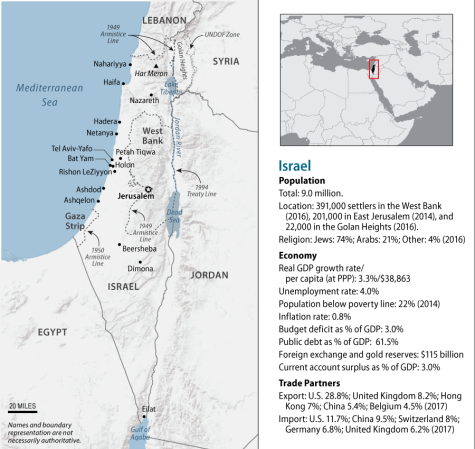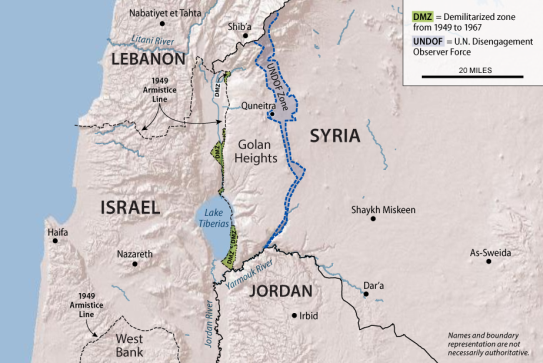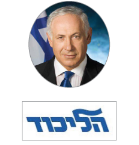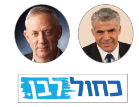Introduction: Major Issues for U.S.-Israel Relations
Strong relations between the United States and Israel have led to bilateral cooperation in many areas. Matters of particular significance include the following:
- Israel's own capabilities for addressing threats, and its cooperation with the United States.
- Shared U.S.-Israel concerns about Iran, within the context of the U.S. exit from the 2015 international nuclear agreement, and growing tension involving Iran and Hezbollah at Israel's northern border with Syria and Lebanon.
- Israeli-Palestinian issues, including those involving Jerusalem, Hamas and the Gaza Strip, funding for Palestinians, and a possible Trump Administration peace plan.
- Israeli domestic political issues, including probable corruption-related indictments against Prime Minister Binyamin Netanyahu and closely contested elections that are scheduled for April 9, 2019.
For background information and analysis on these and other topics, including aid, arms sales, and missile defense cooperation, see CRS Report RL33476, Israel: Background and U.S. Relations, by Jim Zanotti; and CRS Report RL33222, U.S. Foreign Aid to Israel, by Jeremy M. Sharp.
How Israel Addresses Threats
Israel relies on a number of strengths to manage potential threats to its security and existence. These strengths include robust military and homeland security capabilities, as well as close cooperation with the United States.
Military Superiority and Homeland Security Measures
Israel maintains conventional military superiority relative to its neighbors and the Palestinians. Shifts in regional order and evolving asymmetric threats during this decade have led Israel to update its efforts to project military strength, deter attack, and defend its population and borders. Israel appears to have reduced some unconventional threats via missile defense systems, reported cyber defense and warfare capabilities, and other heightened security measures.
Israel has a robust homeland security system featuring sophisticated early warning practices and thorough border and airport security controls; most of the country's buildings have reinforced rooms or shelters engineered to withstand explosions. Israel also has proposed and partially constructed a national border fence network of steel barricades (accompanied at various points by watch towers, patrol roads, intelligence centers, and military brigades) designed to minimize militant infiltration, illegal immigration, and smuggling from Egypt, Syria, Lebanon, Jordan, and the Gaza Strip.1 Additionally, Israeli authorities have built a separation barrier in and around parts of the West Bank.2
 |
|
Notes: According to the Department of State (1) The West Bank is Israeli occupied with current status subject to the 1995 Israeli-Palestinian Interim Agreement; permanent status to be determined through further negotiation. (2) The status of the Gaza Strip is a final status issue to be resolved through negotiations. (3) The United States recognized Jerusalem as Israel's capital in 2017 without taking a position on the specific boundaries of Israeli sovereignty. (4) Boundary representation is not necessarily authoritative. See https://www.state.gov/p/nea/ci/is/. Additionally, the United States recognized the Golan Heights as part of Israel in 2019; however, U.N. Security Council Resolution 497, adopted on December 17, 1981, held that the area of the Golan Heights controlled by Israel's military is occupied territory belonging to Syria. Sources: Graphic created by CRS. Map boundaries and information generated by Hannah Fischer using Department of State Boundaries (2011); Esri (2013); the National Geospatial-Intelligence Agency GeoNames Database (2015); DeLorme (2014). Fact information from CIA, The World Factbook; Economist Intelligence Unit; IMF World Outlook Database; Israel Central Bureau of Statistics. All numbers are estimates and as of 2017 unless specified. |
Undeclared Nuclear Weapons Capability
Israel is not a party to the Nuclear Nonproliferation Treaty (NPT) and maintains a policy of "nuclear opacity" or amimut. A 2017 report estimated that Israel possesses a nuclear arsenal of around 80-85 warheads.3 The United States has countenanced Israel's nuclear ambiguity since 1969, when Israeli Prime Minister Golda Meir and U.S. President Richard Nixon reportedly reached an accord whereby both sides agreed never to acknowledge Israel's nuclear arsenal in public.4 Israel might have nuclear weapons deployable via aircraft, submarine, and ground-based missiles.5 No other Middle Eastern country is generally thought to possess nuclear weapons.
|
China-Israel Commercial Activity and Its Impact on U.S.-Israel Relations U.S. officials have raised some concerns with Israel over Chinese investments in Israeli high-tech companies and civilian infrastructure that could increase China's ability to gather intelligence and steal security-related technologies.6 Some Israeli officials appear to share these concerns.7 Chinese investors reportedly participated in 12% of deals to help finance Israeli tech companies during the first three quarters of 2018.8 For example, a state-owned Chinese company (the Shanghai International Port Group) has secured the contract to operate a new terminal at Haifa's seaport for 25 years (beginning in 2021), and another state-owned Chinese company (a subsidiary of China Harbour Engineering Company) is developing Ashdod's new port.9 Both Haifa and Ashdod host Israeli naval bases. Due to the Chinese contract for Haifa, the U.S. Navy is reportedly reconsidering its practice of periodically docking at the base there.10 Partly because of concerns about China, Israel may create a government body to oversee sensitive commercial deals involving foreign companies.11 Previously, China-Israel defense industry cooperation in the 1990s and 2000s contributed to tension in the U.S.-Israel defense relationship and to an apparent de facto U.S. veto over Israeli arms sales to China.12 |
U.S. Cooperation
Israeli officials closely consult with U.S. counterparts in an effort to influence U.S. decisionmaking on key regional issues, and U.S. law requires the executive branch to take certain actions to preserve Israel's "qualitative military edge," or QME.13 Additionally, a 10-year bilateral military aid memorandum of understanding (MOU)—signed in 2016—commits the United States to provide Israel $3.3 billion in Foreign Military Financing and to spend $500 million annually on joint missile defense programs from FY2019 to FY2028, subject to congressional appropriations.
Israel's leaders and supporters routinely make the case that Israel's security and the broader stability of the region remain critically important for U.S. interests. They also argue that Israel is a valuable U.S. ally.14 The United States and Israel do not have a mutual defense treaty or agreement that provides formal U.S. security guarantees.15
Iran and the Region
Iran remains of primary concern to Israeli officials largely because of (1) Iran's antipathy toward Israel, (2) Iran's broad regional influence,16 and (3) the probability that some constraints on Iran's nuclear program could loosen in the future. In recent years, Israel and Arab Gulf states have discreetly cultivated closer relations with one another in efforts to counter Iran.
Iranian Nuclear Agreement and the U.S. Withdrawal
Prime Minister Netanyahu has sought to influence U.S. decisions on the international agreement on Iran's nuclear program (known as the Joint Comprehensive Plan of Action, or JCPOA). He argued against the JCPOA when it was negotiated in 2015—including in a speech to a joint session of Congress—and welcomed President Trump's May 2018 withdrawal of the United States from the JCPOA and accompanying reimposition of U.S. sanctions on Iran's core economic sectors. A few days before President Trump's May announcement, Netanyahu presented information that Israeli intelligence operatives apparently seized in early 2018 from an Iranian archive. He used the information to question Iran's credibility and highlight its potential to parlay existing know-how into nuclear-weapons breakthroughs after the JCPOA expires.17 In his September 2018 speech before the U.N. General Assembly, Netanyahu claimed that Iran maintains a secret "atomic warehouse for storing massive amounts of equipment and materiel."18 An unnamed U.S. intelligence official was quoted as saying in response, "so far as anyone knows, there is nothing in [the facility Netanyahu identified] that would allow Iran to break out of the JCPOA any faster than it otherwise could."19
After Netanyahu publicly exposed the Iranian nuclear archive, some former Israeli officials speculated about what action Israel might consider taking against Iranian nuclear facilities if Iran abrogates the JCPOA and expands nuclear activities currently restricted under the agreement.20 However, Netanyahu had said in an interview that he was not seeking a military confrontation with Iran.21
Syria22
Israel and Iran have engaged in hostile action over Iran's presence in Syria. In the early years of the Syria conflict, Israel primarily employed air strikes to prevent Iranian weapons shipments destined for the Iran-backed group Hezbollah in Lebanon.23 Later, as the Syrian government regained control of large portions of the country with Iranian backing, Israeli leaders began pledging to prevent Iran from constructing and operating bases or advanced weapons manufacturing facilities in Syria.24 Since 2018, Israeli and Iranian forces have repeatedly targeted one another in and over Syrian- and Israeli-controlled areas.25 In January 2019, Prime Minister Netanyahu said that Israel had targeted Iranian and Hezbollah targets in Syria "hundreds of times."26 Limited Israeli strikes to enforce "redlines" against Iran-backed forces could expand into wider conflict, particularly if there is a miscalculation by one or both sides.
U.S. involvement in Syria could be one factor in Israeli calculations on this issue. The U.S. base at Al Tanf in southern Syria has reportedly "served as a bulwark against Iran's efforts to create a land route for weapons from Iran to Lebanon."27 Israeli officials favor continued U.S. involvement in Syria, while also preparing for the possibility that they may need to take greater direct responsibility for countering Iran there.28
Russia
Russia's advanced air defense systems in Syria could make it more difficult for Israel to operate there. Since 2015, Russia has operated an S-400 system at Russia's Khmeimim air base in Lattakia, a city on Syria's Mediterranean coast. To date, however, Russia does not appear to have acted militarily to thwart Israeli air strikes against Iranian or Syrian targets, and Israel and Russia maintain communications aimed at deconflicting their operations.
In addition to the S-400 that it owns and operates, Russia delivered an S-300 air defense system for Syria's military to Khmeimim airbase in October 2018. The delivery followed Syria's downing of a Russian military surveillance plane in September 2018 under disputed circumstances, shortly after an Israeli operation in the vicinity. According to an Israeli satellite imagery analysis company, three launchers appeared to be operational as of February 2019.29 It is unclear to what extent Russia has transferred the S-300 to Syrian military control, and how this might affect future Israeli military action in Syria. An Israeli journalist wrote that "Israel has the knowledge, experience and equipment to evade the S-300, but the fact that additional batteries, manned by Russian personnel, are on the ground, will necessitate greater care [when carrying out future operations against Iran-aligned targets in Syria]."30 Since the September 2018 incident, Israeli air strikes appear to have decreased somewhat.31
Golan Heights
On March 25, 2019, President Trump signed a proclamation stating that the United States recognizes the Golan Heights (hereinafter, the Golan) to be part of the State of Israel.32 The proclamation stated that "any possible future peace agreement in the region must account for Israel's need to protect itself from Syria and other regional threats"33—presumably including threats from Iran and the Iran-backed Lebanese group Hezbollah. Israel gained control of the Golan from Syria during the 1967 Arab-Israeli war, and effectively annexed it unilaterally by applying Israeli law to the region in 1981 (see Figure 2).34
President Trump's proclamation changed long-standing U.S. policy on the Golan. Since 1967, successive U.S. Administrations supported the general international stance that the Golan is Syrian territory occupied by Israel, with its final status subject to negotiation. In reaction to the U.S. proclamation, others in the international community have insisted that the Golan's status has not changed.35 In Congress, Senate and House bills introduced in February 2019 (S. 567 and H.R. 1372) support Israeli sovereignty claims to the Golan, and would treat the Golan as part of Israel in any existing or future law "relating to appropriations or foreign commerce."
For decades after 1967, various Israeli leaders, reportedly including Prime Minister Netanyahu as late as 2011,36 had entered into indirect talks with Syria aimed at returning some portion of the Golan as part of a lasting peace agreement. However, the effect of civil war on Syria and the surrounding region, including an increase in Iran's presence, may have influenced Netanyahu to shift focus from negotiating with Syria on a "land for peace" basis to obtaining international support for Israel's claims of sovereignty. As part of the periodic conflict in Syria between Israel and Iran, some Iranian missiles have targeted Israeli positions in the Golan.37
The Syrian government has denounced the U.S. policy change as an illegal violation of Syrian sovereignty and territorial integrity, and insisted that Syria is determined to recover the Golan.38 Additionally, observers have argued that the policy change could unintentionally bolster Syrian President Bashar al Asad within Syria by rallying Syrian nationalistic sentiment in opposition to Israel's claims to the Golan and deflecting attention from Iran's activities inside Syria.39
 |
|
Source: CRS, based on data from ArcGIS, U.S. State Department, ESRI, and United Nations. Notes: The DMZs could influence future border demarcation. The United States recognized the Golan Heights to be part of Israel in 2019; however, U.N. Security Council Resolution 497, adopted on December 17, 1981, held that the area of the Golan Heights controlled by Israel's military is occupied territory belonging to Syria. |
Since 1974, the U.N. Disengagement Observer Force (UNDOF) has patrolled an area of the Golan Heights between the regions controlled by Israel and Syria, with about 880 troops from five countries stationed there as of January 2019.40 During that time, Israel's forces in the Golan have not faced serious military resistance to their continued deployment, despite some security threats and diplomatic challenges. Periodic resolutions by the U.N. General Assembly have criticized Israel's occupation as hindering regional peace and Israel's settlement and de facto annexation of the Golan as illegal.41
Hezbollah in Lebanon
Hezbollah's forces and Israel's military have sporadically clashed near the Lebanese border for decades—with the antagonism at times contained in the border area, and at times escalating into broader conflict.42 Speculation persists about the potential for wider conflict and its regional implications.43 Israeli officials have sought to draw attention to Hezbollah's buildup of mostly Iran-supplied weapons—including reported upgrades to the range, precision, and power of its projectiles—and its alleged use of Lebanese civilian areas as strongholds.44
Ongoing tension between Israel and Iran over Iran's presence in Syria raises questions about the potential for Hezbollah's forces in Lebanon to open another front against Israel. After the September 2018 incident leading to Russia's installation of an S-300 system in Syria (discussed above), Iran reportedly began directly transferring weapons to Hezbollah in Lebanon while reducing Syria's use as a transshipment hub.45 One Israeli media account warned that Hezbollah's threat to Israel is increasing because of initiatives to build precision-weapons factories in Lebanon and to set up a military infrastructure in southern Syria.46 In late 2018 and early 2019, Israel's military undertook an effort—dubbed "Operation Northern Shield"—to seal six Hezbollah attack tunnels to prevent them from crossing into Israel.47 Israeli officials claim that they do not want another war, while at the same time taking measures aimed at constraining and deterring Hezbollah, including through consultation with the U.N. Interim Force in Lebanon (UNIFIL).48
Israeli-Palestinian Issues
Recent Complicating Factors
President Trump has expressed interest in brokering a final-status Israeli-Palestinian agreement, and his Administration has supposedly prepared a proposal to facilitate negotiations, but the Administration has repeatedly postponed releasing the proposal. Many factors may account for the delays, including recent U.S. actions regarding Jerusalem, tension in and around the Gaza Strip, reduced funding for the Palestinians, Israeli settlements in the West Bank, and political jockeying and domestic constraints among Israelis and Palestinians.
The U.S. decision—announced in December 2017—to recognize Jerusalem as Israel's capital and move the U.S. embassy there has fed U.S.-Palestinian tensions.49 Israeli leaders generally celebrated the change, but Palestine Liberation Organization (PLO) Chairman and Palestinian Authority (PA) President Mahmoud Abbas strongly objected.50 Many other countries opposed President Trump's actions on Jerusalem, as reflected in action at the United Nations.51 Claiming U.S. bias favoring Israel, Palestinian leaders broke off high-level political contacts with the United States shortly after the December 2017 announcement and have made efforts to advance Palestinian national claims in international fora.52 However, the PA continues security coordination with Israel in the West Bank.53
U.S.-Palestinian tensions appear to have influenced Administration decisions to cut off various types of U.S. funding to the Palestinians,54 and arguably have dimmed prospects for restarting Israeli-Palestinian talks.55 In a September 2018 address before the U.N. General Assembly, PLO Chairman/PA President Abbas denounced Administration actions that he characterized as taking disputed Israeli-Palestinian issues—such as Jerusalem's status and Palestinian refugee claims—off the negotiating table.56
Funding for economic and humanitarian needs in the West Bank and Gaza could become even scarcer. In February 2019, Israel announced that it would withhold a portion of the tax revenue it collects for the PA because—pursuant to a law passed by the Knesset in 2018—Israel had determined that amount represented PLO/PA payments made on behalf of individuals allegedly involved in terrorist acts.57 In response, Abbas announced that the PA would completely reject monthly revenue transfers from Israel if it withheld any amount, even though the transfers comprise approximately 65% of the PA budget.58 For February, Israel withheld approximately $11 million from the $193 million due to the PA, with the PA rejecting the entire amount as a result.59 The PA is reportedly seeking temporary financial support from the private sector and local banks, and also asking the Arab League to follow through on its 2010 decision to provide $100 million per month as a "financial safety net" for the PA.60
At the end of January 2019, U.S. bilateral aid to the Palestinians—including nonlethal security assistance that Israel generally supports—ended completely due to the Anti-Terrorism Clarification Act (ATCA, P.L. 115-253), which became law on October 3, 2018.61 Two months after the law's enactment, PA Prime Minister Rami Hamdallah informed Secretary of State Michael Pompeo that the PA would not accept aid that subjected it to federal court jurisdiction. Apparently, U.S. aid will not resume unless Congress amends or repeals the ATCA, or the Administration channels the aid differently.
|
Gaza's Difficult Security, Political, and Humanitarian Situation The Gaza Strip, a densely populated territory to which access is controlled by Israel and Egypt, faces a precarious security situation linked to poor humanitarian conditions. Because Hamas has controlled Gaza since 2007, Israel and Egypt cite security concerns in limiting the movement of people and goods to and from Gaza, and these limitations have been a factor in preventing Gaza from having a self-sufficient economy. For more information, see CRS Report RL34074, The Palestinians: Background and U.S. Relations, by Jim Zanotti. In this environment, external assistance largely drives humanitarian welfare in Gaza. Significant U.S. and PA reductions in funding for Gaza since 2017 have further affected the humanitarian assessment.62 Some observers assert that funding cuts could make a difficult situation in Gaza worse.63 In fall 2018, Israel started allowing shipments of Qatari fuel and cash into Gaza to partially alleviate the electricity shortages and compensate for the PA funding reductions.64 Popular demonstrations within Gaza over economic conditions have taken place since March 2019, with Hamas blaming the PA for orchestrating the protests and reportedly using violent means to repress them.65 Threats to Israel from Hamas and other militant groups based in Gaza have changed over time.66 Israel and Palestinian militants have engaged in large-scale conflict in Gaza in 2008-2009, 2012, and 2014. Although Palestinian militants maintain rocket and mortar arsenals, Israel's Iron Dome defense system reportedly has decreased the threat to Israel from projectiles during this decade.67 Additionally, tunnels that Palestinian militants used somewhat effectively in the 2014 conflict have been neutralized to some extent by systematic Israeli efforts, with some financial and technological assistance from the United States.68 An Israeli military officer was cited in September 2018 as saying that Hamas is investing fewer resources in tunnels that cross into Israel, but continuing to strengthen tunnels within Gaza that could present difficulties for Israeli soldiers deployed inside the territory during a future conflict.69 Since March 2018, Palestinian protests and violence along security fences that divide Gaza from Israel have attracted international attention.70 Some Gazans have demonstrated "popular resistance" in which crowds gather near the fences, and some people try to breach the fences or use rudimentary weapons (slingshots, basic explosives, burning tires) against Israeli security personnel. Others have used incendiary kites or balloons to set fires to arable land in southern Israel.71 While some of these protests and riots have been organized on a grass-roots level, Hamas has reportedly become more directly involved as the protests have continued.72 Israel has used force in efforts to contain the protests and violence near the Gaza frontier. In June 2018, U.N. General Assembly Resolution ES-10/20 condemned Israeli actions (including the use of live fire) against Palestinian civilians, while also condemning Palestinian rocket attacks from Gaza against Israeli civilians. According to a report from an independent commission mandated by the U.N. Human Rights Council to inquire into the protests, during 2018 Israeli personnel killed 189 Gazans and injured thousands more.73 Israel-Gaza altercations and occasional spikes in violence (including rocket barrages from Gaza and Israeli air strikes inside Gaza) have continued into 2019. On a number of occasions, Israel and Hamas have narrowly averted all-out conflict after exchanges of fire, fueling speculation about the possibility of greater conflict and its regional implications.74 Egypt reportedly continues to broker indirect Israel-Hamas talks aimed at establishing a long-term cease-fire. |
Diplomatic Prospects and Concerns
Assistant to the President and Senior Advisor Jared Kushner has stated that the Administration will publicly release a peace plan sometime after Israeli national elections,75 which are set to occur on April 9, 2019. According to Kushner, the peace plan contains detailed proposals on the various issues that divide Israel and the PLO.76 Many observers express skepticism about the prospect that these proposals can serve as a basis for the serious resumption of bilateral talks, but Kushner has reportedly said that the Administration is focusing on formulating "realistic solutions,"77 and that "privately, people are more flexible."78 U.S. officials hope to surmount potential obstacles to the peace plan in the Israeli and Palestinian domestic arenas by obtaining political and economic support for the U.S. initiative from key Arab states in the region, including Saudi Arabia, the United Arab Emirates, Jordan, and Egypt. A number of Arab states share common interests in working behind the scenes with Israel to counter Iranian regional influence.
While some diplomatic developments have fed speculation about warming Arab-Israeli ties,79 reports suggest that key Arab Gulf states remain reluctant to embrace more formal relations with Israel without a resolution of the Palestinian issue.80 Saudi Arabia's press agency responded to the U.S. recognition of Israel's claims to sovereignty in the Golan Heights by saying that it "will have significant negative effects on the peace process in the Middle East and the security and stability of the region."81
In a statement with implications both for domestic and international audiences, Prime Minister Netanyahu reportedly said that the March 2019 change in U.S. policy on the Golan proves that countries can retain territory captured in a defensive war.82 His statement prompted speculation over the possibility that Israeli leaders might consider annexing part of the West Bank and whether the situation in the Golan is sufficiently similar to invite comparison.83 Days before the April elections, Netanyahu asserted that if he were to lead the next government, he would apply Israeli law to West Bank settlements.84
April 2019 Elections and Other Domestic Issues
The closely contested Israeli national elections—scheduled for April 9, 2019—and the subsequent government formation process will have significant implications for the country's leadership and future policies. Prime Minister Netanyahu faces a challenge from the centrist Blue and White party under the combined leadership of former top general Benny Gantz and former Finance Minister Yair Lapid. Some setbacks for Netanyahu during the campaign have included the attorney general's announcement of probable corruption-related indictments against Netanyahu, new media allegations of possible misconduct relating to Israel's procurement of German submarines,85 and questions about some individuals or groups possibly spreading rumors against Netanyahu's opponents via social media.86 Yet, some observers calculate that Netanyahu's Likud could possibly get fewer Knesset seats than Blue and White and still form the next coalition.87 For more information on the actors involved in the elections, see CRS Insight IN11068, Israel: April 2019 Elections and Probable Indictments Against Prime Minister Netanyahu, by Jim Zanotti and this report's Appendix.
In July 2018, the Knesset passed a Basic Law defining Israel as the national homeland of the Jewish people. Some observers have expressed concern that the law might further undermine the place of Arabs in Israeli society, while others view its effect as mainly symbolic.88 In March 2019, Netanyahu said that Israel is a Jewish, democratic state with equal rights for all its citizens, and "the nation-state not of all its citizens, but only of the Jewish people,"89 reviving domestic debate about the 2018 law and perhaps seeking support during the election campaign from sympathetic voter groups.90
Appendix. Major Israeli Political Parties and Their Leaders
|
RIGHT |
|
|
|
Likud (Consolidation) Leader: Binyamin Netanyahu |
|
|
Yisrael Beitenu (Israel Our Home) Leader: Avigdor Lieberman |
|
|
Union of Right Wing Parties (or United Right) Leader: Rafi Peretz |
|
|
Ha'yamin He'hadash (The New Right) New right-wing party launched from Ha'bayit Ha'Yehudi; supports economic liberalism; opposes the establishment of a Palestinian state. Leader: Naftali Bennett |
|
|
Zehut (Identity) Libertarian Zionist right-of-center party founded in 2015; supports legalizing marijuana, annulling the Oslo Accords, and removing the Palestinian population from the West Bank; opposes U.S. military aid to Israel. Leader: Moshe Feiglin |
|
LEFT |
|
|
|
Labor (Avoda) Leader: Avi Gabbay |
|
|
Meretz (Vigor) Leader: Tamar Zandberg |
|
CENTER |
|
|
|
Kahol Lavan (Blue and White) Merger between two centrist parties, Hosen L'Yisrael (Resilience) and Yesh Atid (There Is a Future). Gantz and Lapid have agreed to take turns as prime minister if elected, with Gantz serving as PM and Lapid as foreign minister for the first two and a half years before switching. Leaders: Benny Gantz and Yair Lapid Born in 1963, Lapid came to politics after a career as a journalist, television presenter, and author. He founded the Yesh Atid party in 2012, and from 2013 to 2014 he served as finance minister. |
|
|
Kulanu (All of Us) Leader: Moshe Kahlon |
|
|
Gesher (Bridge) New center-left party launched in 2018; focused on socioeconomic issues. Leader: Orly Levy-Abekasis |
|
ULTRA-ORTHODOX |
|
|
|
Shas (Sephardic Torah Guardians) Leader: Aryeh Deri |
|
|
United Torah Judaism Leader: Yaakov Litzman |
|
ARAB |
|
|
|
Ra'am (United Arab List) - Balad (National Democratic Assembly) Joint list of conservative Islamist party and pan-Arab nationalist party. Leader: Mansour Abbas |
|
|
Hadash (Democratic Front for Peace and Equality) - Ta'al (Arab Movement for Renewal) Leader: Ayman Odeh |
Sources: Various open sources.













